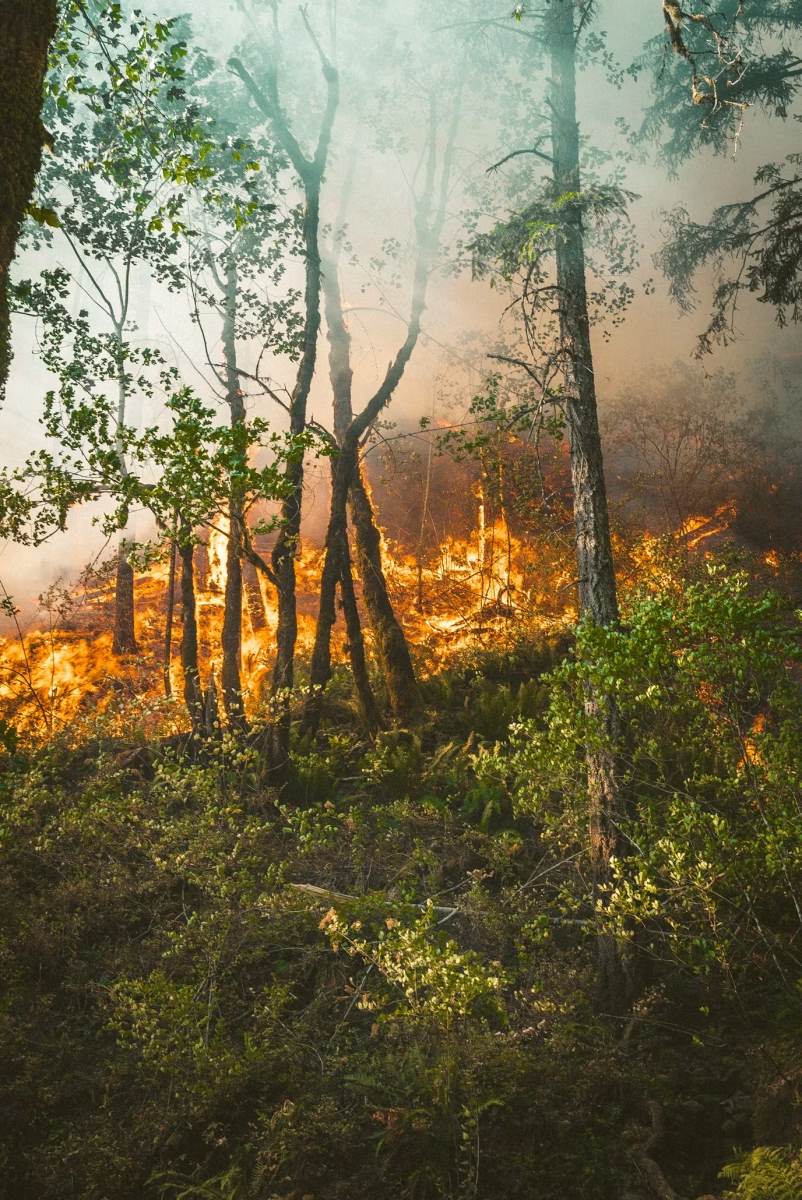(This story was originally published in The Elevator in June, 2022.)
Most people grow up thinking of wolves in a negative light. Children are told stories from a very young age such as Little Red Riding Hood and The Three Little Pigs, all in which the wolf is the antagonist. Whether or not wolves deserve such a negative connotation in society is still up for debate.
There are many different points of view on how wolves in Oregon should be handled. Some want to conserve them while others want to get rid of them. Peoples’ opinions are influenced by their occupations and hobbies. For example, if you are a rancher you might feel differently about wolves than an environmentalist.
Christian Langpap, a professor of Applied Economics at Oregon State University who specializes in endangered species conservation said, “Society does hold a value for these species other than just hunting wolves… which some people enjoy.”
“But there’s also plenty of other people who enjoy, what economists call, non-consumptive use where you enjoy a species just watching it or knowing it exists so it’s safe in its environment since you’re not going to actively harvest it or hunt it,” Langpap said.
I think that wolves are more like a “fantasy,” rather than real, Elise Chirgwin a junior from Oregon City High School said, “I don’t feel a connection to them,” she said, “Because we don’t see them around. I think wolves are good, but I don’t know anything about them.”
Meanwhile, wolves are killing livestock and overhunting, causing lots of stress to farmers and hunters.
The Role of Wolves in the Ecosystem
Wolves are considered a keystone species in a healthy ecosystem and are considered beneficial to some because they help regulate prey populations.
Removing a key species of wolves “knocks ecosystems out of balance,” Langpap said.
When you take a top predator like wolves out of an ecosystem, “the effect kind of ripples out,” Langpap said. Meaning that when the top predator is removed, all the other species below are affected.
The Oregon Department of Fish and Wildlife (ODFW) said on a fact sheet about wolves that, “to prevent serious depletion of any indigenous species and to provide the optimum recreational and aesthetic benefits for present and future generations of the citizens of the state.”
For example, “if there are more deer because there are no wolves, then the vegetation in the ecosystem is going to change, so younger trees are going to get eaten earlier and not have a chance to grow, so the entire vegetation changes in the ecosystem,” Langpap said.
Andrew Johnson, a hunting guide who lives in La Grande near the heart of the wolf populations said he thinks wolves are “a helpful thing to an ecosystem to keep herd populations in check and they will kill the sicker animals, slower animals, [and] easier to catch animals,” but only in areas where there’s not as much hunting pressure and civilization.
Wolf Populations on the Mend
The factsheet by ODFW reported that as of February 10th, 2022, gray wolves outside of the Northern Rocky Mountains are now protected by the Endangered Species Act.
But the majority of the wolves in Oregon, which are in Eastern Oregon, remain off of the Endangered list, because they are within the Northern Rocky Mountain Boundaries.
As of 2021, the minimum count for wolves in Oregon was 175, with 21 documented packs, reported ODFW.
Wolves were previously taken off of the endangered species list in 2015 and are in the process of recovering. Since then, the average rate of population increase has been 8.05%.
U.S. The Fish and Wildlife Service is responsible for protecting endangered species, Langpap said.
The US Endangered Species Act (ESA) is the nation’s most effective law to protect at-risk species from extinction.
“For example, if a wolf is listed, you can’t hunt wolves. You also cannot disturb their habitat,” Langpap said.
According to ODWF, human-caused mortality is currently the number one factor that is preventing full wolf recovery in Oregon. And of the 26 wolf mortalities in 2021, 21 of them were human-caused.
Earlier this year, the Oregon legislature passed a funding bill to support more highway structures for safe wildlife crossing.
“If you look back 25 years, I think we have certainly made progress,” Christian Langpap said, “Wolves have come back since the 1990’s. Before 1990, there were barely any wild wolves in the continental U.S..”
Depletion of Livestock and Game
While wolves may be considered an important part of the ecosystem to some, not everyone holds the same views.
As of December 31, 2022, 312 livestock or domestic animals are confirmed to have been killed by wolves since the 1990s.
“They really don’t help the environment at all,” Andrew Johnson said.
There are “absolutely” too many wolves, he said.
Andrew Johnson has a newly built house in the outskirts of La Grande, with his wife Jessie. They are just now starting to get cows and for them, wolves are a huge concern.
“All it takes is wolves to go through your property one time and kill a calf and it’ll be a big impact on you,” Johnson said, “that could be the difference between making money one year and not making money that year.”
Ranchers are already losing cattle to illnesses, injuries and so on, so having wolves come in on top of that is not good, Johnson said.
In the eyes of a hunter and rancher like Johnson, wolves are just a predator that are “bred to kill.”
The violation of killing a wolf is considered a Class A misdemeanor and has a maximum penalty of a $6,250 fine and time in the county jail for one year.
The exceptions to killing a wolf include in defense of human life or when a wolf is attacking livestock. Wolves can only be killed if they are seen in the act of biting livestock or working dogs, otherwise it is considered unlawful to kill a wolf.
The Oregon State Legislature passed HB 3560 during 2011. This directs the State Department of Agriculture to establish and implement wolf depredation compensation and financial assistance grant programs to compensate people who suffer loss or injury to livestock or working dogs due to wolf depredation. It also provides financial assistance to anyone who implements livestock management techniques or nonlethal wolf deterrence techniques designed to discourage wolf depredation of livestock.
But to people who don’t run cows, it doesn’t even cross their mind, Johnson said, if there’s a thousand wolves out there, it’s not gonna hurt their income at all.
“Wolves are just killing stuff year round and way more than they need to eat,” he said.
Andrew and Jessie have both noticed a big difference in their deer and elk populations in certain areas. “They’re not there anymore because of the wolf impact,” Johnson said.
Wolves are getting more comfortable with us, Johnson said, “We’re not a fear to them.”
Johnson said, “if we needed to lower our elk numbers, we could just give out more elk tags, and hunters would harvest more elk.”
Healthy big game populations are important for Oregon’s citizens and local economies and will also play an important role in achieving wolf conservation in Oregon, stated an FAQ by ODFW.
A Tragedy for the Johnsons
Last winter Andrew Johnson was out hunting with his hounds and one of them was killed by a wolf.
His hound Rowdy was 9 years old at the time and was the first hound Johnson had ever had and is the reason he got into hound hunting.
Johnson mainly hunts in Southeast Union, Eagle cap wilderness, or in the case of this event, Catherine Creek, all of which are about 10 miles from where he lives.
“I’ve always been worried about running my hounds with wolves around, because there’s tons of wolves around where we live,” he said.
I just try to be careful with where I run my dogs, Johnson said, if I was cutting fresh wolf tracks I would go hunt a different area so that I didn’t have to deal with that.
“I was always worried that I was gonna lose a dog to the wolves, but I just tried to be as careful as I could and hunt other places if I knew they were in the area,” he said.
Johnson said this experience made him hate wolves more, on top of already not liking them. He said he got a “new appreciation” for how destructive they are.
“This wolf that killed Rowdy had no intention of killing him to eat him, it just killed him just cause he could,” he said.
Johnson was not compensated by ODFW for the loss of his dog because it was not a “working dog.” Oregon only considers cattle dogs to be working dogs, but when in reality, hound dogs are working dogs to hunters like Johnson.
“I always kind of never got why they were spending so much money into bringing, which is basically an invasive species, down here,” Johnson said.
I think the people in La Grande would be “more apt” to manage wolf populations than the people in Salem who have never even seen a wolf in their lifetime, Johnson said.
“I don’t know what it is to them that’s so special about a wolf,” he said.
The Future of Wolves in Oregon
Growth over the last several years has been rather slow, which is troubling considering that it is estimated that Oregon could sustainably support up to 1,459 wolves across the state.
This year alone there’s been more wolves killed in Union county than ever in the history of Oregon, Johnson said, and just from people seeing them and from livestock getting attacked.
“I personally know of at least 9 wolves that have been killed just within 10 miles of our house,” Johnson said.
“The biggest threat is destruction of habitat,” Langpap said.
Wolves have large ranges so they need a lot of space to live, feed and reproduce, Langpap said, so the more we turn their habitat into developed land or farmland, the less habitat they will have and the harder it will be for them to thrive.
The February 10th, 2022 ruling put wolves outside of the Northern Rocky Mountains back on the Endangered Species list, which should help them recover. Meanwhile, the wolves within the Northern Rocky Mountain boundary are thriving and are currently not endangered.
Wolves have been reintroduced into the ecosystem and have successfully spread west into Oregon, Washington and California, Langpap said.
If this trend continues, we can be “pretty optimistic” about wolves, Langpap said.
In order to help endangered species like wolves, Langpap said, “You can be mindful in your use of the environment and in species habitats.”
The more educated younger people are about environmental issues, the more educated you will be when it comes time to vote, Langpap said, and you can vote for politicians who represent your preferences when it comes to species and environmental issues.
“Environmental groups do good jobs about protecting species, so in the future when you have some discretionary income that you may be able to donate to environmental groups that you think are doing good work in terms of protecting endangered species,” Langpap said, “I think all of those things would be helpful.”







